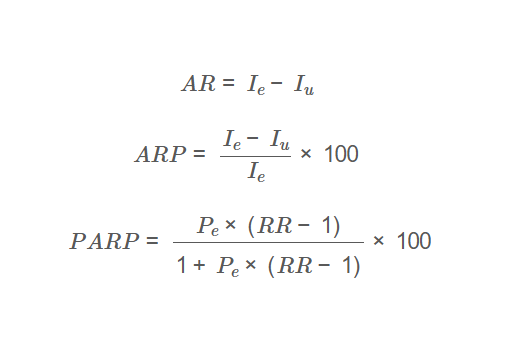 Home
Home
 Back
Back

Definition: This calculator estimates the risk of a disease or outcome attributable to a specific exposure using a 2x2 contingency table. It calculates Attributable Risk (AR), Attributable Risk Percentage (ARP), and Population Attributable Risk Percentage (PARP).
Purpose: It helps researchers, epidemiologists, and healthcare professionals quantify the impact of a risk factor on disease incidence, informing public health interventions and policy decisions.
The calculator uses the following formulas based on a 2x2 contingency table:
Attributable Risk (AR): \[ AR = I_e - I_u \]
Attributable Risk Percentage (ARP): \[ ARP = \frac{I_e - I_u}{I_e} \times 100 \]
Population Attributable Risk Percentage (PARP): \[ PARP = \frac{P_e \times (RR - 1)}{1 + P_e \times (RR - 1)} \times 100 \]
Where:
Steps:
Calculating attributable risk is crucial for:
Example: Consider a study on smoking and cardiovascular disease:
Q: What is the difference between AR and PARP?
A: AR measures the excess risk in the exposed group due to the risk factor, while PARP estimates the proportion of disease in the entire population attributable to the exposure.
Q: Can this calculator be used for retrospective studies?
A: This calculator is designed for prospective studies. For retrospective (e.g., case-control) studies, odds ratios are typically used instead of relative risk, and AR cannot be directly calculated.
Q: How accurate are these calculations?
A: The calculations assume accurate input data and a prospective study design. Confounding factors, biases, or small sample sizes may affect accuracy.